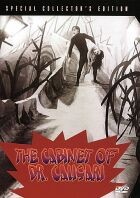
The Cabinet of Dr. Caligari, directed by Robert Wiene and issued in 1920, is perhaps the first important work of cinema, as well as the first horror film, with images that echo through the genre to this day. The story is relatively simple, but strange. A side-show hypnotist named Caligari (Werner Krauss) exhibits a somnambulist named Cesare (Conrad Veidt)--a man who has apparently remained in a catatonic state for 23 years. Yet Cesare is able to predict the deaths of those in the carnival audience. The deaths occur soon afterwards as murders, which are eventually traced to Cesare under the control of the mad Caligari, who is later shown to be the head of a mental institution. There is a twist ending, part of a framing story narrated by "Francis," which I will not reveal.
Caligari is a true expressionist film, using distorted, painted sets, lighting effects, and mannered acting to illuminate internal psychological states rather than linear narrative. As I said, some images resonate with nearly every other horror film since: e.g., the pale, black-garbed Cesare carrying off the heroine "Jane" into the night over painted-matte rooftops. More has been written about this film than can possibly be cited here, but arguments still rage as to whether there are political implications that foreshadow the rise of Nazism, specifically, the psychotic Caligari's position of control.
What remains now is to distinguish between the only two good DVD versions available: the 2002 Kino "official restored version" or the 1997 Image version. Neither is entirely faultless. The newer Kino DVD was transferred from an excellent 35mm German archival print and correctly tinted/toned according to the original textual sources. The picture is very crisp if perhaps a bit bright; the colored expressionistic inter-titles scroll in imitation of the original hand-colored inter-titles of the earliest prints--a novel feature changed in prints made from 1923 onward to conform to ordinary stationary black and white titles; it also preserves the original six-act structure of the initial release that was later suppressed. The Kino edition has two musical scores, one an unsuitable modern orchestral score, the other a synthesized score by Donald Sosin more in keeping with the mood, but neither is stylish. There are generous bonuses: a 43-minute condensation of the same director's 1920 Genuine: The Tale of A Vampire (or perhaps that's all that survives), a huge number of publicity photos, and even footage of director Robert Wiene at work.
The 1997 Image version was transferred from a 35mm Russian print of the 1923 German reissue, and correctly tinted. The picture isn't as immediately clean as Kino's but it's somehow more honest and detailed; the inter-titles, while they are colored to reproduce the expressionist style of the originals, do not scroll like them: it is possible that no original prints with the scrolling were known to the restorers at the time of the transfer, and the division into six acts is not preserved. There is one musical score but it is far superior to either of Kino's: Timothy Brock composed a wonderful string ensemble accompaniment in exactly the post-Romantic German style of the period (not dissimilar from early Schoenberg, though by 1920, the music of the greatest German composers--Schoenberg, Berg, and Webern--had moved on to atonality). Bonuses include a sparse 3-minute excerpt from Genuine... compared to Kino's 43 minutes, a few publicity posters, and a fascinating, informative audio commentary by film scholar Mike Budd. Curiously, the package refers to two commentaries, but that may simply refer to the two subjects with which the commentator deals: the specifics of the film and the historical background.
Both versions are projected at the correct rate of 18 frames-per-second. A choice between the two is virtually impossible, as both have serious drawbacks: between minutes 2:00 and 5:08 in the Kino version, the blue tinting bleaches out the black level, making the result look like experimental video. The telecine colorist was apparently asleep at the switch; it's very unsettling. The Image version has a translucent dark line near the top of the picture during many scenes which Image assures us is in the print; it is an erroneously positioned frame-line they felt it better to leave rather than crop the frame. I agree that cropping the frame would have been a bad idea but why select a print with such a problem in the first place? Image slightly shrinks and "window-boxes" the frame so that no edge information is lost to TV overscanning. Kino is not "window-boxed" and there is a small amount of information lost at the edges. Curiously, however, when played on a computer monitor, which does not overscan like a TV, or when using the "shrink" feature available on some DVD players (like the Toshiba SD-1800), the full Kino frame appears to have more at the edges than the frame of the Image print.
If you are a connoisseur of great early cinematic art, you will need both Image and Kino editions: the Image for the correctly transferred opening minutes, the great Timothy Brock score, and illuminating commentary; the Kino for a picture undisturbed by a misplaced translucent frame-line, scrolling inter-titles, division into the original six acts, and more generous extras.
Review by Robert E. Seletsky
| Released by Image and Kino DVD |
| Region 1 NTSC |
| Not Rated |
| Extras : see main review |